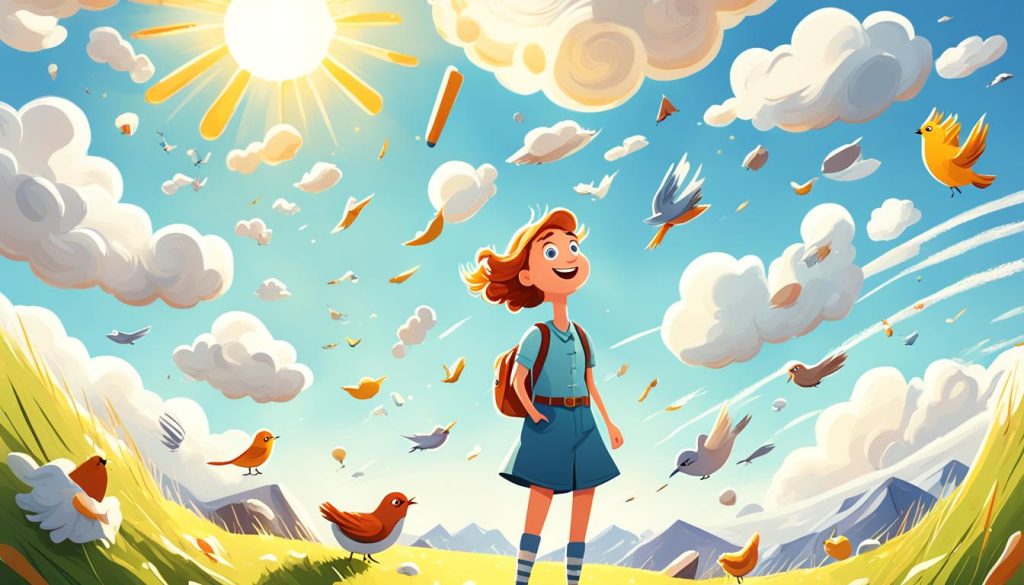How to Draw a Cloud – Drawing Turorials and Coloring Tips
Are you curious about the secrets behind drawing realistic and captivating clouds? Do you want to learn easy techniques to enhance your cloud drawing skills? Look no further! In this article, we will guide you through step-by-step tutorials and provide expert tips and tricks to help you master the art of drawing clouds.
Whether you are a beginner or an experienced artist looking to refine your cloud drawing abilities, we’ve got you covered. From understanding different cloud shapes and types to adding depth and realism through shading and coloring techniques, you’ll discover everything you need to create stunning cloud drawings that truly stand out.
So, are you ready to explore the fascinating world of cloud drawing? Let’s dive in and unlock the secrets to creating breathtaking clouds in your artwork.
Key Takeaways:
- Learn step-by-step cloud drawing techniques to create realistic and vibrant clouds.
- Understand the importance of clouds in enhancing the overall composition and impact of your artwork.
- Explore different types and shapes of clouds to accurately depict them in your drawings.
- Discover shading, texture, and shadowing techniques to add depth and realism to your cloud drawings.
- Master coloring techniques and color choices for creating stunning skies and vibrant clouds in your artwork.
Why Drawing Clouds is Important in Art
Clouds are not just puffy formations in the sky; they hold immense artistic significance in the world of art. Incorporating clouds in your artwork can add depth, atmosphere, and visual interest to your compositions. By mastering different cloud drawing techniques, you can create realistic skies that bring your artwork to life.
When it comes to landscape and sky drawings, clouds play a crucial role. They contribute to the overall composition and impact of your art. The way you depict clouds can evoke specific moods and emotions, whether it’s a dramatic stormy sky or a peaceful sunset.
Learning how to draw clouds allows you to exercise your artistic skills in capturing the ethereal beauty of nature. By observing and recreating various cloud formations, you can enhance your understanding of light, shadow, and perspective.
Moreover, clouds offer a unique opportunity to experiment with different drawing techniques. Depending on the type of clouds you choose to depict, you can explore various shading and texture methods to bring dimension and realism to your artwork.
“Clouds come floating into my life, no longer to carry rain or usher storm, but to add color to my sunset sky.” – Rabindranath Tagore
Clouds are not simply background fillers; they have the power to transform a mundane sky into a captivating masterpiece. Artists throughout history have recognized the importance of clouds in their work, using them to create captivating and evocative scenes.
Artists Who Incorporate Clouds in Their Artwork
Many renowned artists have incorporated clouds into their artwork, showcasing their artistic significance. For example, artist John Constable was known for his landscape paintings that prominently featured realistic and dramatic cloud formations. His keen observation of the sky and skillful depiction of clouds added a sense of mood and atmosphere to his artworks.
Similarly, in the famous painting “The Starry Night” by Vincent van Gogh, swirling clouds dominate the night sky, contributing to the dreamlike and expressive quality of the artwork.
By studying the works of these artists and others, you can gain inspiration and learn new techniques for incorporating clouds into your own artwork.
In conclusion, drawing clouds is essential for any artist looking to create captivating landscapes and skies. Whether you’re striving for realism or aiming to evoke a specific mood, understanding how to draw clouds and incorporating them into your artwork can greatly enhance its overall impact and artistic value.
Different Shapes and Types of Clouds
Clouds come in various shapes and types, each with its own characteristics and appearance. By familiarizing yourself with different cloud formations, you can accurately depict them in your drawings. Let’s explore the characteristics and techniques for drawing a wide range of cloud shapes and types.
1. Cumulus Clouds
Cumulus clouds are large, fluffy clouds with a flat base and rounded top. They resemble cotton balls and are commonly associated with fair weather. To draw a cumulus cloud, start with a basic oval shape and add layers of puffy, curved lines to create its distinct form. Use shading to add depth and highlight the fluffy texture of the cloud.
2. Cirrus Clouds
Cirrus clouds are thin and wispy, appearing high in the sky. They are composed of ice crystals and are often indicators of changing weather. Drawing cirrus clouds requires delicate lines and subtle shading to capture the ethereal nature of these clouds. Use long, curving strokes to depict their elongated shape and fine details.
3. Stratus Clouds
Stratus clouds are low-lying and can cover large areas of the sky. They are flat, featureless clouds that often bring overcast weather conditions. To draw stratus clouds, create layers of overlapping, horizontal lines with soft edges. Use shading to indicate the thickness and depth of these expansive clouds.
4. Nimbus Clouds
Nimbus clouds, also known as rain clouds, are dark and dense with a vertical development. They bring precipitation and are often associated with stormy weather. To draw nimbus clouds, use bold and sweeping strokes to create a sense of movement and heaviness. Add shading to depict the depth and intensity of the cloud’s structure.
| Cloud Type | Description | Drawing Technique |
|---|---|---|
| Cumulus Clouds | Large, fluffy clouds with a flat base and rounded top | Start with an oval shape and add puffy, curved lines for texture |
| Cirrus Clouds | Thin and wispy clouds found high in the sky | Use delicate lines and subtle shading to capture their ethereal nature |
| Stratus Clouds | Low-lying, flat clouds that often cover large areas of the sky | Create layers of overlapping, horizontal lines |
| Nimbus Clouds | Dark and dense clouds associated with stormy weather | Use bold strokes and shading to depict movement and heaviness |
By understanding the characteristics of different cloud shapes and types, you can bring depth and realism to your cloud drawings. Experiment with various techniques and explore the unique beauty of each cloud formation. Now, let’s move on to the next section to learn a step-by-step cloud drawing tutorial.
Step-by-Step Cloud Drawing Tutorial
Are you ready to create your own beautiful clouds? Follow our step-by-step cloud drawing tutorial that is specifically designed for beginners. We will guide you through the process, starting with simple shapes and gradually adding details to achieve a realistic and three-dimensional effect. By the end of this tutorial, you will have the foundational skills needed to draw impressive clouds.
To begin, gather your drawing materials, including paper, pencils, an eraser, and a blending tool. Find a comfortable and well-lit workspace where you can fully concentrate on your drawing.
Drawing the Basic Cloud Shape
- Start by drawing a simple oval shape on your paper. This will serve as the base of your cloud.
- Next, add fluffy curves and irregular shapes around the oval to create the outline of the cloud.
- Use light and gentle strokes to maintain a soft and airy appearance.
- Don’t worry about achieving perfection in this stage, as clouds have natural variations in shape and texture.
Adding Dimension with Shading and Highlights
- Now, it’s time to add depth and dimension to your cloud drawing.
- Observe the light source in your reference image or imagine it coming from a specific direction.
- Using a darker pencil or shading tool, create shadows on the underside of the cloud’s curves and edges.
- Blend the shadows gently using a blending tool or your finger to create a smooth transition.
- Next, use an eraser or a kneaded eraser to create highlights on the top portions of the cloud.
- Erase small sections to mimic the sunlight hitting the cloud, giving it a more realistic appearance.
Final Touches and Details
Now that your cloud has depth, it’s time to add some final touches and details to enhance its realism.
- You can refine the shape of your cloud by adding smaller curves or elongating certain sections.
- Pay attention to the reference image or visualize how the clouds naturally form and adjust accordingly.
- Within the cloud, you can create smaller cloud formations or wisps by adding delicate curves or strokes.
- Remember to blend and shade these smaller details to maintain harmony and depth in your drawing.

Congratulations! You have completed the step-by-step cloud drawing tutorial for beginners. Take a step back and admire your beautiful creation. Now that you’ve learned the fundamentals, feel free to experiment with different cloud shapes, sizes, and textures. With practice and patience, you’ll be able to master the art of drawing clouds and create stunning skies in your artwork.
Adding Realism to Your Cloud Drawings
To make your cloud drawings more realistic, it’s essential to understand shading, texture, and shadowing techniques. By incorporating these elements into your artwork, you can create visually stunning and lifelike clouds that add depth and dimension to your compositions.
Shading Clouds
Shading is a crucial aspect of creating realistic clouds. It involves adding variations in value to depict the play of light and shadow on the cloud surfaces. Start by observing real clouds or reference images to understand how light interacts with different parts of the cloud. Use a light pencil to lightly shade the areas that are farther away from the light source and gradually increase the pressure to darken the areas that receive more light.
An effective technique is to use hatching or cross-hatching to create the illusion of depth and volume. This involves drawing parallel lines or intersecting lines to simulate the subtle shifts in tonal values.

Creating Texture in Clouds
Texture is another crucial element in making your cloud drawings look realistic. Clouds have a soft, billowy appearance, so it’s important to capture their unique texture. Use a combination of short, curved lines and small circles to represent the fluffiness and irregularity of cloud formations. Vary the size and direction of these marks to create a sense of randomness.
Pro Tip: Don’t be afraid to experiment with different mark-making techniques. Try using a blending stump, cotton swab, or even a soft brush to blend and soften your pencil strokes, mimicking the softness of clouds.
Adding Shadows to Clouds
Shadows are essential for creating depth and realism in your cloud drawings. Determine the direction of the light source and identify the areas where shadows would fall on the clouds. Use a slightly darker value to fill in these shadow areas, paying attention to the shape and contours of the clouds. By adding shadows, you can create a sense of volume and make the clouds appear more three-dimensional.
Mastering Realistic Cloud Drawings
Mastering the art of realistic cloud drawings requires practice and experimentation. Study the works of renowned artists who specialize in landscape and cloud drawings, and analyze their techniques. Keep refining your shading, texture, and shadowing skills by consistently practicing and observing the clouds around you. With time and dedication, you’ll be able to create breathtaking cloud drawings that captivate viewers.
Coloring Tips for Cloud Drawings
Choosing the right colors for your cloud drawings is essential in creating captivating and realistic artwork. The colors you select can greatly impact the overall look and feel of your clouds and skies. In this section, we will explore various coloring techniques and provide valuable tips for making your cloud drawings come alive with vibrant colors.
Color Choices for Clouds
When choosing colors for your clouds, it’s important to consider the type of cloud you are drawing. Different cloud formations can have distinct color variations. For example, cumulus clouds often have bright white tops and shaded undersides, while stratus clouds tend to be more muted in color.
To create depth and dimension, consider adding subtle variations of color within each cloud. This can be achieved by using slight variations of your base color or introducing shades of gray or blue to enhance shadow and highlight areas. Experiment with different color combinations to find the perfect balance for your clouds.
Cloud Coloring Techniques
There are various coloring techniques you can use to bring your cloud drawings to life:
- Blending: Blend different colors together using a soft brush or blending tools to create a smooth transition between shades, giving your clouds a realistic and soft appearance.
- Layering: Gradually build up layers of color to create depth and texture in your clouds. Start with lighter colors as a base and add darker shades on top to create the illusion of shadows and volume.
- Highlighting: Use a lighter color or white to highlight the highest parts of your clouds, adding brightness and realism to your artwork.
Remember to observe real clouds and reference images for inspiration. Pay attention to how light interacts with the clouds, as this will guide your color choices and help you create a more realistic representation.
Creating Realistic Skies
In addition to coloring clouds, creating realistic skies is crucial in achieving a convincing atmosphere in your artwork. Consider the following tips:
- Gradient Background: Create a gradient background by blending different shades of blue from the top to the bottom of your drawing, mimicking the natural transition of color in the sky.
- Adding Depth: Use lighter shades of blue for the distant sky and gradually darken the color as you move closer to the horizon. This technique adds depth and perspective to your skies.
- Introducing Atmospheric Effects: Enhance the realism of your skies by incorporating subtle touches such as wispy clouds, sunsets, or rays of light breaking through the clouds.
By combining these techniques and experimenting with different color choices, you can create breathtaking cloud drawings with realistic skies that captivate viewers.

Remember, the key to effective coloring is practice and experimentation. Don’t be afraid to step outside your comfort zone and try new colors or techniques. With time and patience, you’ll develop your own unique style and create stunning cloud drawings that evoke a sense of wonder and beauty.
Tips and Tricks for Mastering Cloud Drawing Skills
Drawing clouds is a skill that can be improved with practice and patience. To help you hone your cloud drawing techniques, we have compiled a list of valuable tips and tricks that will elevate your cloud drawings to the next level. Whether you are a beginner or have some experience, these insights will enhance your cloud drawing skills and allow you to create realistic and captivating clouds.
1. Observe Real Clouds:
A great way to improve your cloud drawing skills is to observe real clouds. Spend time outdoors, look up at the sky, and pay attention to the different shapes, textures, and movements of the clouds. By studying the intricacies of clouds in nature, you’ll gain a deeper understanding of their characteristics and be able to recreate them more accurately in your drawings.
2. Experiment with Different Drawing Tools:
Don’t be afraid to try out different drawing tools to find the ones that work best for you. Experiment with pencils, pens, charcoals, or digital drawing tablets to explore different techniques and achieve various effects in your cloud drawings. Each tool offers unique possibilities, and finding the right one for your style can greatly improve your cloud drawing skills.
3. Understand Light and Shadow:
Mastering light and shadow is essential for creating realistic clouds. Study how light interacts with clouds and learn to accurately portray the shadows and highlights. Understanding the play of light on a cloud’s surface will add depth and dimension to your drawings, making them more visually striking.
4. Practice Layering and Blending:
Layering and blending techniques can add depth and texture to your cloud drawings. Experiment with different pencil strokes, shading techniques, and blending tools to create realistic cloud formations. By blending colors smoothly and layering different shades, you’ll achieve a more vibrant and three-dimensional look in your cloud drawings.
5. Use Reference Images:
Reference images can be valuable tools for improving your cloud drawing skills. Look for photographs or artwork featuring clouds, and use them as a reference to guide your drawings. Reference images can provide inspiration, help you understand cloud formations, and assist in creating accurate depictions of clouds in different lighting and weather conditions.
“The sky is filled with moments; sky snapshots you borrow from the clouds and keep for yourself forever.” – Michelle Geaney
6. Practice Regularly:
Like any skill, practice is key to honing your cloud drawing techniques. Set aside dedicated time to practice drawing clouds and make it a regular part of your artistic routine. The more you practice, the more confident and skilled you will become at capturing the beauty of clouds in your drawings.
Remember, improving your cloud drawing skills takes time and effort, so be patient with yourself. With dedication and practice, you can master the art of drawing clouds and create stunning works of art that captivate viewers with their beauty and realism.

| Tips | Tricks |
|---|---|
| Observe real clouds | Experiment with different drawing tools |
| Understand light and shadow | Practice layering and blending |
| Use reference images | Practice regularly |
Finding Inspiration for Cloud Drawings
Finding inspiration is the key to creating unique and captivating cloud drawings. Immersing yourself in the beauty of nature can provide an abundance of ideas and references for your artwork. Here are some ways to find inspiration for your cloud drawings:
- Observe Clouds in Nature: Spend time outdoors and take note of the various cloud formations you come across. Look at how they change shape, move across the sky, and interact with the surrounding environment. These observations will help you capture the essence of clouds in your drawings.
- Cloud Reference Images: Use online resources or photography books to gather a collection of cloud reference images. These images can serve as a visual guide and provide inspiration for different types of clouds, textures, and lighting effects. Incorporate elements from these images into your drawings to add realism and depth.
- Experiment with Perspective: Change your perspective and view clouds from different angles. By looking up, down, or sideways, you can discover unique compositions and perspectives that can be translated into your drawings. Don’t be afraid to experiment and explore unconventional viewpoints.
- Seek Artistic Inspiration: Look for renowned artists and their cloud-related artwork. Study their styles, techniques, and use of colors to gather ideas for your own drawings. Pay attention to how they capture the light, shadows, and atmosphere in their cloud representations.
By combining these sources of inspiration, you can develop your own artistic style and create cloud drawings that evoke emotions and resonate with viewers.
“Clouds come floating into my life, no longer to carry rain or usher storm, but to add color to my sunset sky.” – Rabindranath Tagore
Remember, inspiration can strike at any moment, so keep a sketchbook handy to jot down ideas and sketches whenever inspiration strikes. Let the beauty of the skies guide your hand as you bring your cloud drawings to life.

| Sources of Inspiration | Description |
|---|---|
| Observing Clouds in Nature | Spending time outdoors to observe cloud formations, movement, and interactions with the environment. |
| Cloud Reference Images | Using online resources or photography books to gather a collection of cloud reference images. |
| Experimenting with Perspective | Changing your viewpoint and exploring different angles to discover unique compositions. |
| Seeking Artistic Inspiration | Studying renowned artists and their cloud-related artwork for techniques and styles. |
Conclusion
Drawing clouds is an exciting and rewarding skill to add to your artistic repertoire. Throughout this article, we have provided step-by-step tutorials, valuable tips, and techniques to help you create stunning and realistic cloud drawings. By implementing these methods, you can elevate the overall quality of your artwork and capture the beauty of the sky in all its glory.
Remember to practice regularly and embrace experimentation. Cloud drawing is a skill that requires patience and dedication to master. As you continue to hone your craft, you will develop your own unique style and perspective. So, don’t be afraid to let your imagination soar and have fun with your cloud drawings.
Whether you are a beginner or an experienced artist, the knowledge and insights shared in this article will provide you with a solid foundation for drawing clouds. Use the various techniques for shading, creating texture, and adding depth to bring your clouds to life. Experiment with different coloring techniques to create vibrant and realistic skies. With time and practice, you will be able to create breathtaking cloud drawings that showcase your artistic prowess.






